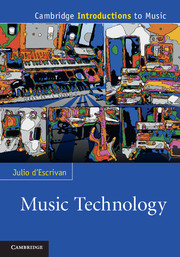Book contents
- Frontmatter
- Contents
- Preface
- Acknowledgements
- Figures
- Chapter 1 Representing and storing sound
- Chapter 2 A studio overview
- Chapter 3 Synthesisers, samplers and drum machines
- Chapter 4 Live music technology (the FAQs)
- Chapter 5 Select, remix, mashup
- Chapter 6 The producer
- Chapter 7 Music, sound and visual media
- Chapter 8 The studio as experimental lab
- Chapter 9 Controllers: new creative possibilities in performance
- Chapter 10 Hacking electronics for music
- Further avenues for exploration
- Notes
- Glossary
- Bibliography
- Index
Chapter 2 - A studio overview
Published online by Cambridge University Press: 05 June 2012
- Frontmatter
- Contents
- Preface
- Acknowledgements
- Figures
- Chapter 1 Representing and storing sound
- Chapter 2 A studio overview
- Chapter 3 Synthesisers, samplers and drum machines
- Chapter 4 Live music technology (the FAQs)
- Chapter 5 Select, remix, mashup
- Chapter 6 The producer
- Chapter 7 Music, sound and visual media
- Chapter 8 The studio as experimental lab
- Chapter 9 Controllers: new creative possibilities in performance
- Chapter 10 Hacking electronics for music
- Further avenues for exploration
- Notes
- Glossary
- Bibliography
- Index
Summary
In this chapter we will look at the sound studio and its elements. We will consider the role of the mixing desk and how it is organised for the management of the audio signal. We will also discuss using microphones and how they fit into the recording workflow. Today, recording is not just a matter of capturing sound on hard disk or (digital) tape, it is also the process of recording data about performance through MIDI sequencing. For this reason we will discuss the MIDI protocol and examine it in some detail. Since audio sequencers capture both MIDI and audio within essentially the same workflow, we will look at how they differ from, yet complement, each other in creative applications.
In Chapter 1, we examined sound; now we need to look at the business of working with sound in the studio. When sound is turned into a signal to be transmitted or recorded for later reproduction, we refer to it as audio. The sound studio has traditionally been the place for working with audio, whether for broadcast or for the recording industry. The computer age has changed all this and anybody with a personal computer (or even a smartphone!) can have access to sound studios implemented through software. Since software studios aim to emulate the traditional hardware studios, we can use them as useful models to illustrate how we deal with audio. In this chapter, I would like to give an overview of the basic elements of the studio, with emphasis on the mixer and possible listening environments. In Chapter 3 we will look at software recording, and this will complement the topic by further examining the recording of both audio and MIDI.
The resources you will need can be safely grouped into categories of audio input, processing, storage and audio output. In the first category, we will find the tools we need for capturing the sound source (mics) or creating it (turntables, synths or electric guitars); in the second we have tools for managing different sources of sound at the same time, setting their levels and changing the character of the sound (pre-amplifiers, mixers, effects units compressors, gates, etc.); in the third we have devices for storing the sound (hard-disk recorders, digital tape, solid-state memory or even analogue tape); and in the fourth we have loudspeakers and listening environments.
- Type
- Chapter
- Information
- Music Technology , pp. 21 - 71Publisher: Cambridge University PressPrint publication year: 2011

